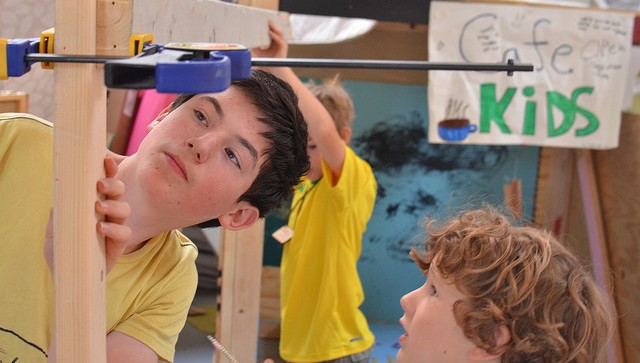
In New Haven, Connecticut, where I live with my husband and two sons, we are lucky to have nearby the Eli Whitney Museum. This place is the opposite of a please don't touch repository of fine art. It's an "experimental learning workshop" where kids engage in an essential but increasingly rare activity: they make stuff. Right now, looking around my living room, I can see lots of the stuff made there by my older son: a model ship that can move around in water with the aid of a battery-powered motor he put together; a "camera obscura" that can project a real-world scene onto a wall in a darkened room; a wooden pinball game he designed himself. (You can view an archive of Eli Whitney Museum projects here.)
The people who run Eli Whitney call these hands-on projects "experiments." As they put it: "Experiments are a way of learning things. They require self-guided trial and error, active exploration, and testing by all the senses. Experiments begin with important questions, questions that make you think or that inspire you to create." This process of exploring, testing and finding out is vital to children's intellectual and psychological development—but opportunities to engage in it are fewer than they once were. “My friends and I grew up playing around in the garage, fixing our cars,” says Frank Keil, a Yale University psychologist who is in his early 60's. “Today kids are sealed in a silicon bubble. They don’t know how anything works.”
Many others have noticed this phenomenon. Engineering professors report that students now enter college without the kind of hands-on expertise they once unfailingly possessed. At the Massachusetts Institute of Technology, “we scour the country looking for young builders and inventors,” says Kim Vandiver, dean for undergraduate research. “They’re getting harder and harder to find.” MIT now offers classes and extracurricular activities devoted to taking things apart and putting them together, an effort to teach students the skills their fathers and grandfathers learned curbside on weekend afternoons.
Why should this matter? Some would argue that the digital age has rendered such technical know-how obsolete. Our omnipresent devices work the way we want them to (well, most of the time), with no skill required beyond pushing a button. What’s to be gained by knowing how they work?
Actually, a lot. Research in the science of learning shows that hands-on building projects help young people conceptualize ideas and understand issues in greater depth. In an experiment described in the International Journal of Engineering Education in 2009, for example, one group of eighth-graders was taught about water resources in the traditional way: classroom lectures, handouts and worksheets. Meanwhile, a group of their classmates explored the same subject by designing and constructing a water purification device. The students in the second group learned the material better: they knew more about the importance of clean drinking water and how it is produced, and they engaged in deeper and more complex thinking in response to open-ended questions on water resources and water quality.

